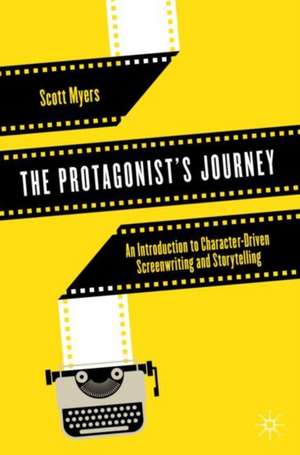The Protagonist's Journey: An Introduction to Character-Driven Screenwriting and Storytelling
Autor Scott Myersen Limba Engleză Paperback – 28 mar 2022
Character drives plot. Based on this principle, this book walks aspiring writers through the fascinating world of character-driven screenwriting. When a writer engages their characters, they start a process which naturally leads to the story’s structure and everything else that makes for a well-written narrative. Exploring the protagonist’s journey and their “unity arc,” Myers explains how a family of characters surrounds the protagonist and influences their transformation process. This easy-to-follow guide features activities that will help writers of any level develop their stories from concept to scene-by-scene outline. Based upon a popular workshop Myers has led with over a thousand writers at all levels of experience, this book is a must-have for screenwriting students, both undergraduate and graduate, and those looking at advanced story development.
Preț: 141.15 lei
Nou
Puncte Express: 212
Preț estimativ în valută:
27.01€ • 28.88$ • 22.52£
27.01€ • 28.88$ • 22.52£
Carte disponibilă
Livrare economică 27 martie-10 aprilie
Livrare express 12-18 martie pentru 31.65 lei
Preluare comenzi: 021 569.72.76
Specificații
ISBN-13: 9783030796815
ISBN-10: 3030796817
Pagini: 393
Ilustrații: XXXVI, 339 p. 198 illus., 81 illus. in color.
Dimensiuni: 155 x 235 x 27 mm
Greutate: 0.53 kg
Ediția:1st ed. 2022
Editura: Springer International Publishing
Colecția Palgrave Macmillan
Locul publicării:Cham, Switzerland
ISBN-10: 3030796817
Pagini: 393
Ilustrații: XXXVI, 339 p. 198 illus., 81 illus. in color.
Dimensiuni: 155 x 235 x 27 mm
Greutate: 0.53 kg
Ediția:1st ed. 2022
Editura: Springer International Publishing
Colecția Palgrave Macmillan
Locul publicării:Cham, Switzerland
Cuprins
Part I: The Protagonist’s Journey as Narrative Imperative.- Chapter One: The Protagonist’s Journey – Due to their central role, engaging the Protagonist is the most important aspect of the story-crafting process.- Chapter Two: Character Arc – In movies, there exists a recurring variety of character arcs including the most popular: positive transformation.- Chapter Three: Disunity – The Protagonist needs to change as reflected in their initial state of disunity.- Chapter Four: Deconstruction – Entering the New World, a series of challenges and trials deconstructs the Protagonist’s old ways of being.- Chapter Five: Reconstruction – Freed from their old ways of being, the Protagonist is reconstructed by embracing heretofore untapped inner potential.-Chapter Six: Unity – The Protagonist brings together all they have learned in the story’s final struggle and in doing so achieves unity.- Chapter Seven: The Protagonist’s Place Within the Screenplay Universe – The Protagonist’s journey interweaves between the External World and the Internal World.- Part II: The Protagonist’s Journey as Family of Characters.- Chapter Eight: Primary Character Archetypes – Five narrative dynamics common to movies represented by these archetypes: Protagonist, Nemesis, Attractor, Mentor, Trickster.- Chapter Nine: Nemesis – By providing opposition to the Protagonist, the Nemesis generates sustained conflict which creates the central drama of the story.- Chapter Ten: Attractor – During their journey, the Protagonist intersects with Attractor characters who connect with the Protagonist’s emotional development.- Chapter Eleven: Mentor – The Protagonist meets another type of ally, the Mentor who provides wisdom and contributes to the Protagonist’s intellectual growth.- Chapter Twelve: Trickster – A shapeshifter tests the will of the Protagonist by switching from ally to enemy, enemy to ally, and generating complications.- Chapter Thirteen: Subplots – Each Protagonist relationship with key characters is a mini-story with its own arc, theme, and contribution to the overall narrative.- Chapter Fourteen: Character Map – There is a structure to the Protagonist’s relationships with the story’s major characters.- Part III: The Protagonist’s Journey as Screenplay.- Chapter Fifteen: Breaking the Story I – Begin the story-crafting process by engaging the story’s central character with a Protagonist Character Treatment.- Chapter Sixteen: Breaking the Story II – Use a series of brainstorming exercises to explore the story universe and develop its characters.- Chapter Seventeen: Breaking the Story III – A first pass at wrangling the plot by working with Four Primary Plotline Points.- Chapter Eighteen: Breaking the Story IV – Track the Protagonist’s transformation arc through Four Themeline Movements.- Chapter Nineteen: Breaking the Story V – Expand the framework of the plot by identifying Ten Major Plotline Points.- Chapter Twenty: Breaking the Story VI – Construct the final story structure, both Plotline and Themeline into a Narrative Throughline.- Chapter Twenty-One: Writing the First Draft – Break down the writing process into sets of scenes from one Plotline Point to another all the way through the Denouement.
Notă biografică
Scott Myers has written thirty projects for nearly every major Hollywood studio and broadcast network. He hosts GoIntoTheStory.com, which Writers’ Digest named “Best of the Best Scriptwriting Website.” An assistant professor at DePaul University, USA, Scott is a graduate of the University of Virginia and Yale University Divinity School, USA.
Textul de pe ultima copertă
Character drives plot. Based on this principle, this book walks aspiring writers through the fascinating world of character-driven screenwriting. When a writer engages their characters, they start a process which naturally leads to the story’s structure and everything else that makes for a well-written narrative. Exploring the protagonist’s journey and their “unity arc,” Myers explains how a family of characters surrounds the protagonist and influences their transformation process. This easy-to-follow guide features activities that will help writers of any level develop their stories from concept to scene-by-scene outline. Based upon a popular workshop Myers has led with over a thousand writers at all levels of experience, this book is a must-have for screenwriting students, both undergraduate and graduate, and those looking at advanced story development.
Caracteristici
Provides a new set of terminology to help students construct the interior and exterior arcs of character
Includes a diverse range of case studies, from Hollywood classics to contemporary feature films and television
Marks the first book-length study to take a Jungian approach to screenwriting
Includes a diverse range of case studies, from Hollywood classics to contemporary feature films and television
Marks the first book-length study to take a Jungian approach to screenwriting
